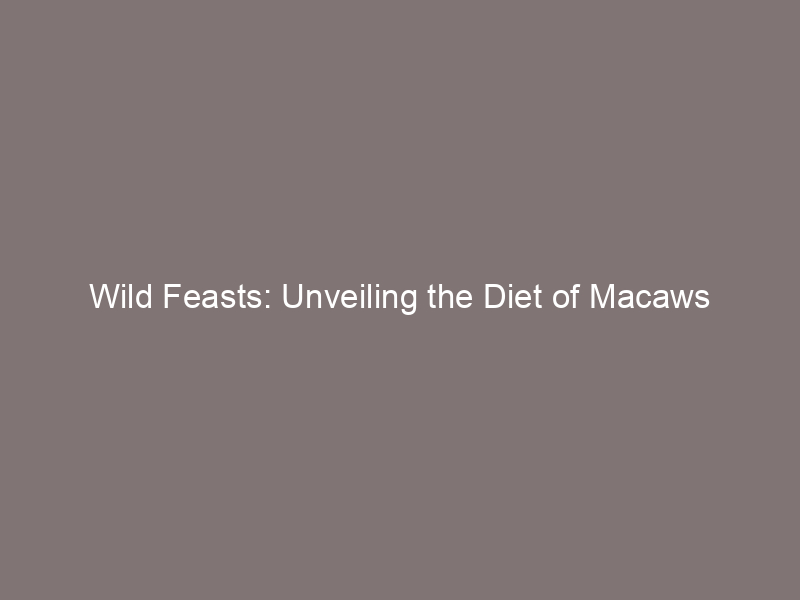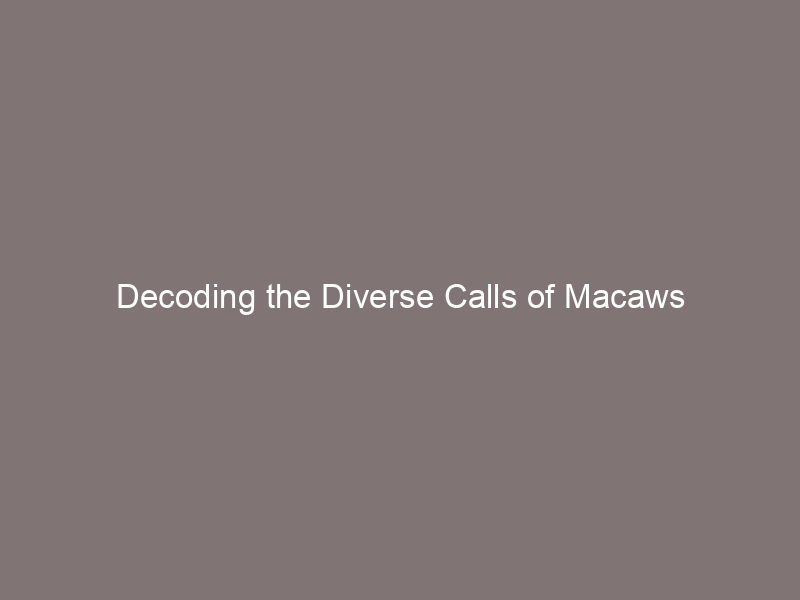Introduction to Macaws
Hey there, bird lovers! Today, we’re going to chat about a super cool type of bird – the Macaw. These birds are not just pretty to look at, but they’re also full of surprises. So, let’s dive right in and learn some fun facts about Macaws!
-
Overview of Macaws
Macaws are a type of parrot that are known for their bright colors and large size. They’re native to Central and South America, and they love to hang out in rainforests, savannas, and even high in the mountains. Macaws have strong beaks that can crack nuts and seeds, while their dry, scaly tongues have a bone inside them that makes it easy to tap into fruits. Wikipedia has some more cool info about these vibrant birds.
-
Macaw Species Biodiversity
Did you know there are about 19 species of macaws? Yep, that’s right! Each species has its own unique colors and patterns. Some of the most popular ones are the Blue and Gold Macaw, Scarlet Macaw, and the Green-winged Macaw. But sadly, some types of Macaws are in danger. The Spix’s Macaw and the Glaucous Macaw are both considered to be extinct in the wild. That’s why it’s so important to protect these amazing birds and their habitats.
So, that’s a quick intro to Macaws. But there’s so much more to learn about these fascinating birds. Stick around as we explore more about their role in ecosystems, their habitats, and how we can help conserve them. Stay tuned!
Macaw Species Role in Ecosystems
Macaws, with their vibrant colors and loud voices, are not just beautiful to look at. They also play a crucial role in the ecosystems they inhabit. Let’s dive into the world of Macaws and explore their impact on the environment.
Macaw Ecosystem Impact
Macaws are much more than just pretty birds. They are key players in the health and survival of their ecosystems. Here’s why:
- Importance of Macaws in the ecosystem
- Macaw species environmental role
Macaws are known as ‘ecosystem engineers’. This means they help shape the environment they live in. One of the ways they do this is by spreading seeds around. When they eat fruits and nuts, some seeds pass through their system and get dropped in new locations. This helps new plants grow, which in turn provides food and shelter for other animals. In this way, Macaws help keep the forest healthy and diverse.
Macaws also play a role in keeping the balance in their environment. They are one of the top predators in their ecosystem. This means they help control the population of smaller animals and insects they feed on. By doing this, they prevent these populations from getting too large and causing damage to the ecosystem. So, Macaws are not just beautiful, they are also important guardians of their habitats.
So, next time you see a Macaw, remember they are not just a pretty face. They are hard at work, helping to keep their ecosystems healthy and balanced. They truly are the vibrant architects of their environments.
Macaw Species Ecosystem Services
Hey there, parrot pals! Today we’re going to talk about some super cool things that our feathered friends, the Macaws, do for their homes in the wild. They’re not just pretty faces, you know. They play a big part in keeping their ecosystems healthy and happy. Let’s dive in!
- Seed Dispersal
- Forest Regeneration
Ever wonder how plants spread their seeds far and wide? Well, one way is through birds like Macaws. When Macaws munch on fruits, they swallow the seeds. Then, when they fly off and do their business elsewhere, they’re actually planting new trees! This is called seed dispersal. It’s like they’re little gardeners of the sky! According to Wikipedia, some Macaw species can disperse seeds over distances of up to 15 kilometers. That’s a lot of flying and planting!
Now, remember those seeds they’re spreading around? They grow into new trees and plants. This is known as forest regeneration. So, in a way, Macaws help to rebuild and maintain their own homes. It’s like they’re tiny architects, designing and building the forest. They help to keep the forest full of life and diversity. Isn’t that amazing?
So, next time you see a Macaw, remember they’re not just beautiful birds. They’re important members of their ecosystems, helping to keep the forests healthy and full of life. They’re truly the vibrant architects of their ecosystems!
Macaw Species Habitat
Macaws are super cool birds that live in some pretty amazing places. Let’s take a closer look at their habitats and what they need to live happily and healthily.
Habitat Requirements
Just like us, macaws need certain things in their homes to keep them safe and well. Let’s check out two of the most important ones:
- Nesting sites
- Food sources
Macaws love to make their nests in tall trees or on cliffs. They need a safe place high up where they can lay their eggs and raise their chicks. The nests are usually in holes in trees or in the side of cliffs. This keeps them safe from predators on the ground. Wikipedia tells us that some species even prefer palm trees for their nests!
Macaws eat a diet that’s full of fruits, nuts, and seeds. They need to live in places where these foods are easy to find. Some macaws even eat clay from riverbanks to help them digest their food. Isn’t that interesting?
So, to sum it up, macaws need a safe place to nest and plenty of yummy food to eat. But remember, not all macaws are the same. Different species may have different habitat needs. Isn’t it amazing how these colorful birds adapt to their surroundings?
Habitat Threats
Macaws, like many other creatures, face some big challenges in their natural habitats. Let’s take a closer look at two of the biggest threats they’re up against.
- Deforestation
- Illegal Pet Trade
Deforestation is a huge problem for Macaws. These birds need trees for nesting and food. When forests are cut down, Macaws lose their homes and their food sources. According to Wikipedia, around 15.3 million hectares of forest are destroyed globally each year. That’s a lot of lost homes for our feathered friends!
Another big threat to Macaws is the illegal pet trade. Some people think these colorful birds would make cool pets, so they capture them from the wild. This is bad news for the Macaws, as they are often kept in poor conditions and can’t live their natural lives. Wikipedia states that thousands of parrots, including Macaws, are captured each year for the pet trade. This is a big no-no and is harmful to these beautiful birds.
As you can see, Macaws are facing some serious threats. But don’t worry, there are ways we can help. Stay tuned to learn more about Macaw conservation in the next section!
Macaw Species Conservation
Hey there, parrot pals! Today, we’re going to chat about something super important – the conservation of our feathered friends, the Macaws. These colorful characters are facing some tough times, but there are some cool things happening to help them out.
Conservation Efforts
There are two main ways that people are working hard to protect Macaws. Let’s take a look at them:
- Protected Areas
- Breeding Programs
One of the best ways to keep Macaws safe is by protecting the places where they live. This means setting up special areas where people can’t cut down trees or hunt. It’s like creating a giant ‘no disturb’ zone for our bird buddies. For example, the Tambopata Reservation in Peru is a protected area where many Macaws live.
Another way to help Macaws is through breeding programs. These are special places where Macaws are encouraged to have babies, which are then released into the wild. This helps to increase their numbers and give them a fighting chance. A great example is the Al Wabra Wildlife Preservation in Qatar, which runs a successful breeding program for the Spix’s Macaw.
So, there you have it! These are just a couple of the ways that people are helping to protect Macaws. It’s a big job, but with everyone’s help, we can make sure these beautiful birds continue to brighten up our world.
How to Support Conservation
Hey there, parrot pals! You know, we can all play a part in helping our feathered friends, the Macaws. Here are a couple of ways you can lend a hand (or a wing) to support Macaw conservation.
- Adopt a Macaw
- Support Conservation Organizations
One of the coolest ways to help is by adopting a Macaw. No, you don’t get to bring one home (they’re happiest in the wild, after all). But your adoption money goes towards protecting their habitats and funding research. It’s like being a superhero for Macaws! You can adopt a Macaw through organizations like the World Wildlife Fund.
There are loads of organizations out there working hard to protect Macaws and their homes. By donating money, volunteering your time, or even just spreading the word about their work, you’re making a big difference. Some awesome groups to check out include the American Bird Conservancy and the Rainforest Foundation.
Remember, every little bit helps. Let’s all do our part to keep the world wild about parrots!
Effects of Macaws on Ecosystems
Macaws, with their vibrant colors and loud squawks, do more than just add beauty to the world. They play a crucial role in their ecosystems. Let’s look at some of the positive effects these magnificent birds have.
Positive Effects
Macaws are like the superheroes of the forest. They do some pretty amazing things that help the environment. Here are a couple of their superpowers:
- Promotion of Forest Growth
- Biodiversity Enhancement
Did you know that macaws are like nature’s gardeners? They eat a lot of fruit and nuts, and when they fly around, they drop the seeds from these foods. This helps new plants to grow. It’s like they’re planting trees without even knowing it! According to Wikipedia, this is a process called seed dispersal, and it’s super important for keeping forests healthy and growing.
Macaws also help to increase biodiversity. That’s a big word that means the variety of different types of life in a certain area. Because macaws move seeds around, they help lots of different types of plants to grow. This, in turn, attracts a variety of animals to the area. So, by being nature’s gardeners, macaws help to create a rich, diverse ecosystem.
So, the next time you see a macaw, remember that they’re not just pretty birds. They’re hard workers that play a big part in keeping our planet healthy and diverse.
Negative Effects
Just like all creatures, Macaws can sometimes have a negative impact on their environment. Let’s take a look at two main ways this can happen:
- Overconsumption of Certain Food Sources
- Potential Spread of Diseases
Macaws are known for their love of fruits, nuts, and seeds. But sometimes, they can eat a bit too much! When Macaws overeat certain types of food, it can cause an imbalance in the ecosystem. For example, if they eat too many seeds from one type of tree, that tree might not be able to grow as much as it should. This can lead to fewer trees and less diversity in the forest. It’s like when you eat all the cookies in the cookie jar – there’s none left for anyone else!
Macaws, like other birds, can sometimes carry diseases. If a Macaw gets sick, it can spread the disease to other birds and animals in the ecosystem. This can be harmful to the health of the entire forest. It’s kind of like when one kid in your class gets a cold, and then everyone else starts sneezing too. It’s important for us to keep an eye on the health of Macaws to prevent the spread of diseases.
Even though Macaws can sometimes have these negative effects, it’s important to remember that they are a crucial part of their ecosystems. We need to work together to protect them and their habitats. Remember, a healthy Macaw means a healthy forest!
Macaw Species Ecological Importance
Macaws are more than just pretty birds. They play a vital role in the health and balance of our ecosystems. Let’s explore how they do this.
Ecological Role of Macaws
Macaws have two main roles in the ecosystem. They act as seed dispersers and as prey for larger predators. Let’s dive into these roles a bit more.
- As seed dispersers:
- As prey for larger predators:
Macaws love to eat fruits, nuts, and seeds. But did you know that when they eat, they also help plants grow? That’s right! When a macaw eats a fruit and flies away, it eventually poops out the seeds in a different place. This helps new plants grow in new places. It’s like they’re nature’s gardeners!
It might be sad to think about, but macaws are also food for larger animals. Eagles, large snakes, and even big cats like jaguars sometimes eat macaws. This is part of the circle of life in the wild. It helps keep the balance in nature.
So, you see, macaws are really important for our environment. They help plants grow and they are part of the food chain. Next time you see a macaw, remember how important they are!
Macaws and Biodiversity
Macaws, with their vibrant colors and loud calls, play a big part in the richness and stability of our ecosystems. Let’s dive into how they do this!
- Contribution to Species Richness
- Impact on Ecosystem Stability
Species richness is a fancy term for the number of different species in a certain area. Macaws add to this richness in a big way! They eat a lot of fruits and nuts, and when they poop, they spread the seeds of these plants around. This helps new plants grow in different places, adding to the variety of plant species in the area. Wikipedia has some cool info on this if you want to learn more.
Macaws also help keep the ecosystem stable. This means they help keep everything in balance. When they eat, they’re not just feeding themselves, but also the plants they spread through their poop. Plus, they’re a tasty meal for larger predators. This cycle of eating and being eaten helps keep the number of different species in check, so no one species takes over. It’s like they’re the peacekeepers of the jungle!
So, the next time you see a macaw, remember, they’re not just pretty birds. They’re hardworking members of their ecosystems, helping keep everything in balance and adding to the variety of life in their habitats.
Conclusion: The Vibrant Architects of Their Ecosystems
As we’ve explored in this post, macaws are much more than just pretty birds. They play a crucial role in their ecosystems, helping to maintain the balance of nature. Let’s wrap up with a summary of what we’ve learned and why it’s so important to protect these vibrant architects of their ecosystems.
- Summary of Macaw’s role in ecosystems
- Importance of conservation efforts
Macaws are like the gardeners of the rainforest. They spread seeds far and wide, helping to grow new plants and trees. This not only keeps the forest healthy, but it also provides food and shelter for other animals. Plus, their love for clay licks helps to recycle nutrients in the soil. In short, macaws are essential for keeping their ecosystems alive and thriving. Learn more about Macaw’s role in ecosystems here.
Unfortunately, many macaw species are threatened by habitat loss and illegal pet trade. That’s why conservation efforts are so important. By protecting their habitats and enforcing laws against illegal trade, we can help ensure that macaws continue to brighten up our world and play their vital role in the ecosystem. Remember, every little bit helps. Even something as simple as learning about macaws and sharing what you’ve learned can make a difference. Find out more about Macaw conservation efforts here.
In conclusion, macaws are truly the vibrant architects of their ecosystems. They help to shape and sustain the world around them, making it a more colorful and diverse place. So next time you see a macaw, remember: you’re not just looking at a beautiful bird. You’re looking at a key player in the circle of life.






